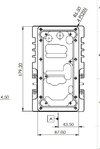Hi,
Do you agree, these SMD FETs with top heat tabs should never be used?....
[EDIT]...This question is in relation to an SMPS PCB inside an aluminium box with a 1cm thickness all round (all 6 sides) .....as such, that will be used for the heatsinking, otherwise its a waste of such a thick box. ie a square box, 4 sides, and top and bottom). The box is approx 20cm x 10cm x 7cm [END OF EDIT]
IAUS260N10S5N019T
Because..
1...They are a rarity and can go nil-stocked easily
2....Its too complicated to do heatsink connection for them (as opposed to bottom tab to thermal vias on PCB, to bottom copper, to insulate pad, to heatsink)
3.....There is no way to search any search engine to find and pull out those SMD FETs with top side heat tab.
4....They are always more expensive to buy.
5.....Their heatsinking arrangement is always more expensive than "normal" SMD FETs...the heatsink needs "gouging out" to make room for the FET....machining from solid.
Do you agree, these SMD FETs with top heat tabs should never be used?....
[EDIT]...This question is in relation to an SMPS PCB inside an aluminium box with a 1cm thickness all round (all 6 sides) .....as such, that will be used for the heatsinking, otherwise its a waste of such a thick box. ie a square box, 4 sides, and top and bottom). The box is approx 20cm x 10cm x 7cm [END OF EDIT]
IAUS260N10S5N019T
Because..
1...They are a rarity and can go nil-stocked easily
2....Its too complicated to do heatsink connection for them (as opposed to bottom tab to thermal vias on PCB, to bottom copper, to insulate pad, to heatsink)
3.....There is no way to search any search engine to find and pull out those SMD FETs with top side heat tab.
4....They are always more expensive to buy.
5.....Their heatsinking arrangement is always more expensive than "normal" SMD FETs...the heatsink needs "gouging out" to make room for the FET....machining from solid.
Last edited:




